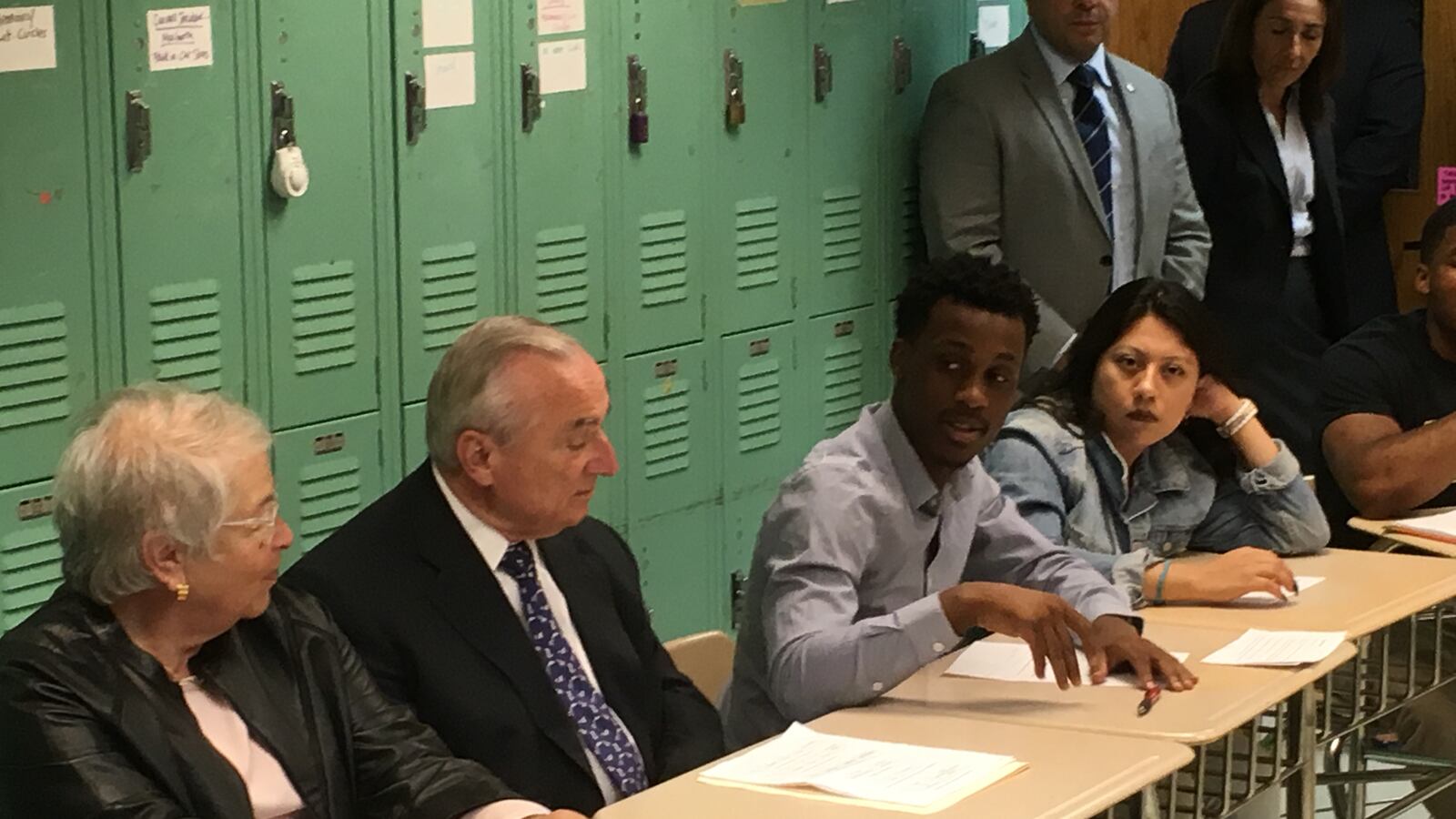City officials released new school safety data Thursday that show crime and school-related arrests are falling, but also reveal a more complete picture of persistent racial disparities in student interactions with police.
The numbers were announced at a joint press conference with schools chief Carmen Fariña and police Commissioner William Bratton, who touted statistics that show “index” crimes in the city’s public schools — the most serious offenses — are down 35 percent over the past five years.
They also pointed to school-based arrests, which are down 8.9 percent, according to NYPD data, and summonses issued at school, which have dropped by roughly 37 percent over the same time frame.
“I anticipate that we’re going to continue to see a drop in all kinds of crime in our schools,” Fariña said, referring in part to the city’s efforts to promote holistic responses like restorative justice rather than a zero-tolerance approach. “This is not just about soft words, it’s about a very concrete action.”
But what went almost entirely unaddressed in the press conference is the deep divide between students of color and their white peers in how they are treated by police inside their schools.
For the first time this year, the NYPD was required to release data on student interactions with regular precinct officers who are called to schools, in addition to school safety agents posted in schools. In previous reports, the NYPD only released data on incidents involving school safety agents.
As Chalkbeat reported last month, the department missed the deadline for providing those numbers. Thursday’s release comes weeks after it was legally required.
The most recent data, which covers April through June 2016, show that black students are more likely to be arrested and restrained than their white peers.
Black students made up 53 percent of the 397 arrests inside schools, despite representing just 27 percent of the city’s students, according to a Chalkbeat analysis. Hispanic students are slightly underrepresented. They made up 33.5 percent of student arrests, and comprise 40.5 percent the overall student body.
But white students, who make nearly 15 percent of the city’s students, accounted for just 6.3 percent of the arrests, or 25 total.
And while there was some narrowing of racial disparities in student arrests between the first and second quarters, activists said they were still unacceptable.
“The second quarter school safety data shows the racial inequities we saw in the first quarter were not an aberration, but part of a pattern of criminalization of black and brown youth in our schools and city,” wrote Kesi Foster, an organizer at the Urban Youth Collaborative, in a press release. “We are still waiting for transformative policy changes.”
Several other advocacy organizations, including Advocates for Children and the New York Civil Liberties Union, also independently called on the city to come up with a comprehensive plan to significantly reduce racial disparities in student interactions with police.
The use of restraints dipped from 673 instances in the first quarter of 2016 to 554 in the second quarter, but there were still stark racial gaps. Black students represented 59.4 percent of those restrained, compared with Hispanic students (30 percent) and white students (4 percent).
The youngest student restrained in the second quarter of 2016 was seven years old, and 20 students 12 or younger were handcuffed.
Roughly 250 summonses were issued to students, many of them for minor offenses such as disorderly conduct or marijuana possession. Some of the students were as young as 16, and more than half of them were black. Students issued summonses at school can become ensnared in the criminal justice system, explained Advocates for Children, for “minor misbehavior that does not rise the level of a crime.”
“While the data shows a welcome decline in school crime,” Advocates for Children wrote in a press release, “the second quarter data suggests that some school staff have not received appropriate de-escalation training and some schools do not have appropriate de-escalation plans in place to manage students in emotional crisis.”
The city education department referred questions about racial disparities and the policies governing the use of restraints to the NYPD, which did not immediately respond to a request for comment. In a press release, the city highlighted $47 million in annual funding for “school climate initiatives and mental health supports” to “manage incidents and address underlying issues head-on.”
During the press conference, NYPD Assistant Chief Brian Conroy, who heads the school safety division, also noted that officers recovered 2,053 weapons during the 2015-16 school year, including seven firearms, compared with 1,673 weapons and nine firearms the year before.
Addressing the year-over-year increase, Conroy downplayed the idea that more confiscated weapons shows schools are more dangerous. “We really feel that we’re just being better at identifying the students that have weapons, either through scanning or through other means — teachers having great relationships with other students,” he said.

